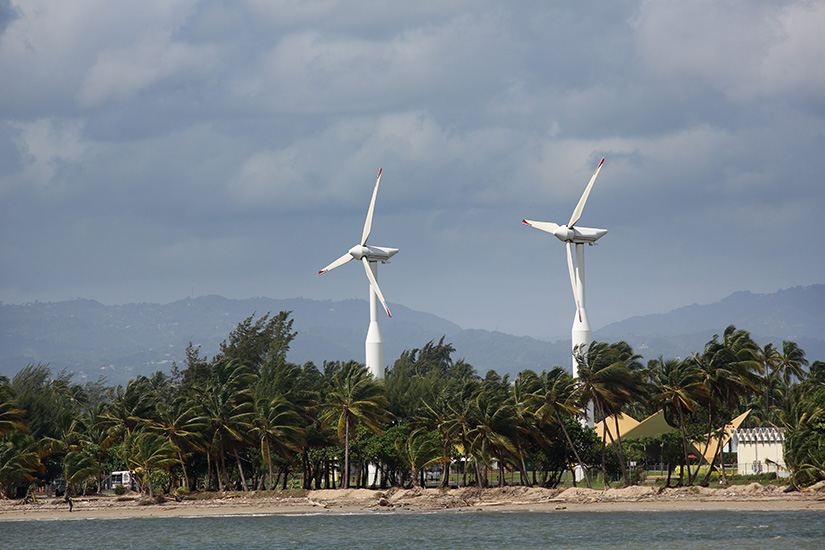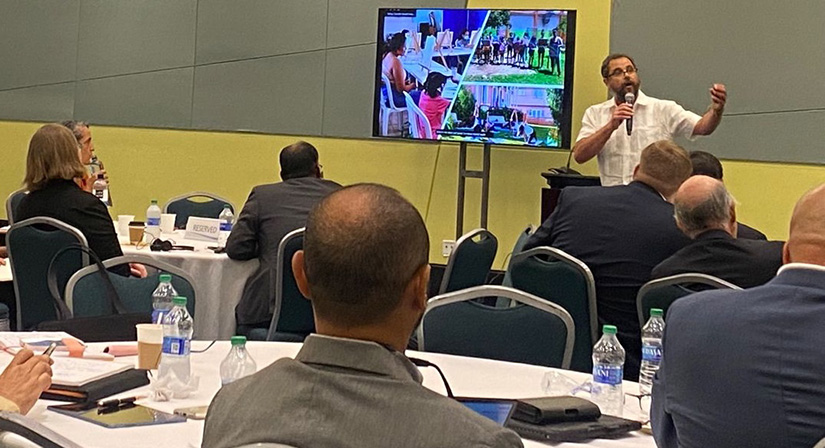Puerto Rican Voices Propel PR100 Study Forward
Powerful Insights, Resources Available at Halfway Mark of Stakeholder-Driven, Multilab Effort

In September 2022—almost exactly five years after Hurricane Maria—Puerto Rico was hit by Hurricane Fiona. In the aftermath, some residents spent up to two weeks with no power.
A study of pathways to a more resilient energy grid was already underway in the Puerto Rico Grid Resilience and Transitions to 100% Renewable Energy Study (PR100). The stakeholder-driven project is finding ways for Puerto Rico to reach its goal of 100% renewable electricity by 2050. Nearly 100 Puerto Rico energy system stakeholders—including businesses, the utility company, the housing authority, environmental organizations, universities, energy justice advocates, government officials, and solar and storage developers—are providing input on the research study.
The PR100 one-year update on progress made during the first year of this two-year, stakeholder-informed study was presented to the advisory group of stakeholders and then to the public in a webinar for nearly 850 highly engaged participants on January 23. The webinar (also recorded in Spanish) featured remarks from the National Renewable Energy Laboratory’s (NREL’s) director, Martin Keller, as well as Energy Secretary Jennifer M. Granholm, Federal Emergency Management Agency (FEMA) Administrator Deanne Criswell, and Puerto Rico Governor Pedro Pierluisi.
“We got additional feedback, which will help us fine-tune our analysis by filling some data and information gaps,” said Murali Baggu, NREL's laboratory program manager for grid integration and the study’s co-principal investigator.
In addition to tapping NREL for analysis and decision support to inform policies and strategies for achieving Puerto Rico’s decarbonization and energy resilience goals, the project leverages the research capabilities of Argonne, Lawrence Berkeley, Oak Ridge, Pacific Northwest, and Sandia national laboratories.
For its part, NREL is using its state-of-the-art Sienna modeling framework for production cost modeling to inform grid scheduling. Leveraging Sienna’s accurate representations and scalable modeling capabilities, the PR100 team is accurately reflecting the challenges—climate-driven (e.g., hurricanes) and economic—facing the Puerto Rican energy system to support Puerto Rico’s efforts to ensure energy system development plans will be reliable and cost-effective through 2050.
The analysis and modeling project will demonstrate the mix of solar photovoltaics, battery energy storage, wind energy, and infrastructure expansion (both at the grid scale and for individual buildings) that is most achievable, cost-effective, and resilient against disruptions.
“The impact of Hurricane Fiona accelerated the need for outcomes from the study,” Baggu said. “We had requests from the energy secretary and other governmental agencies to see if there are any near-term considerations that we can put out at this one-year mark of the study.”
Renewable Energy Can Withstand Natural Disasters
Secretary of Energy Jennifer Granholm participated in the October meeting of the PR100 advisory group, which was “a real opportunity for stakeholders to speak directly to her about their experiences of impacts after Fiona,” explained NREL’s Robin Burton, the study’s co-principal investigator.
“It’s important that we took time to listen and understand what did and did not work for Puerto Ricans before, during, and after the hurricane. We need to be able to address what matters most in our PR100 study, and we wanted to be sure we still understood the community’s priorities,” said Marisol Bonnet, U.S. Department of Energy lead for PR100.
The PR100 team learned from stakeholders about two community-based microgrids that stayed online and provided value when the grid went down. As an example, a fishing enterprise near the coast that had a solar and storage system continued operating in the aftermath of the storm.
As the PR100 team generated their interim results for the one-year mark of the study, the Hurricane Fiona listening sessions reminded them “to keep accelerating and making sure the information we're producing really does inform investment decisions that need to happen in the near term,” Burton said.

Puerto Rican Priorities Shape PR100 Scenarios
One of the overarching principles of the PR100 study is a commitment to energy justice, Burton explained.
“We were really keeping procedural justice in mind as we were identifying stakeholders to include in our advisory group” she said. “We wanted a representative cross section of stakeholders informing the study. NREL has been providing support for energy system recovery and resilience to Puerto Rico since after Hurricane Maria, so we were able to engage with established contacts from across sectors to invite a breadth of voices into the conversation.”
NREL has also subcontracted with Hispanic Federation to facilitate the advisory group and give input on the stakeholder engagement process.
Many stakeholders have expressed interest in distributed energy resources (DERs) and deploying residential rooftop solar paired with battery energy storage. With extensive input from the advisory group, the PR100 team initially defined four potential scenarios for Puerto Rico to reach its goal of 100% renewable electricity by 2050 that used a mix of these technologies and were defined by different priorities:
- Economic adoption of DERs based on payback periods for individual building owners
- DER deployment for critical services as well as economic adoption
- Equitable DER deployment for remote and low- to moderate-income communities as well as Scenario 2
- Maximum DER deployment to reach the maximum number of rooftops with enough photovoltaics and storage to meet critical loads.
Key near-term considerations include:
- Accelerate the deployment of rooftop solar and storage, as well as utility-scale solar and wind (double the current rate reaches 2050 economic deployment, quadruple the current rate reaches it by 2035)
- Improve investment planning beyond current procurement plans
- Upgrade the transmission and distribution system to accommodate new renewable generation resources
- Modernize the grid with high-fidelity sensors, models, and updated grid codes to support transmission and distribution upgrades
- Prioritize equitable access to affordable, resilient electricity for the most vulnerable utility customers.
Baggu emphasized, “The study should look at near-term investments keeping in mind there are no stranded assets in the future. So, beyond current procurement plans, we want to make sure the investment considerations really keep in mind the future needs for the archipelago so that we can reach those long-term goals.
“As we analyze the transmission and distribution system upgrade needs to accommodate new renewable generation,” Baggu continued, “there is an immediate need for updated grid codes and installation of new sensors to accommodate the growth and modernize the grid. We will be also looking at equitable access of energy for the most vulnerable customers.”
20-Year Solar and Wind Data Sets
The PR100 team has produced publicly available resources to inform project planning: 20-year data sets for solar and wind energy, including offshore wind potential.
“These are really needed to understand the diversity and the capacity factor of the resources,” Baggu said. “So we used these along with the load growth projections and DER adoption to come up with feasible scenarios.”
The solar and wind data sets will prove valuable not just to the PR100 research team but also more broadly to regional developers and investors to make investment decisions.
“This is very important data, especially for developers and investors,” Baggu said. “If they really need to understand what the production of new systems will look like in a specific location or in a specific place, these are some good data sets to use.”
Balancing Land-Use Priorities and Utility-Scale Generation
Since much of Puerto Rico’s land is designated for agricultural use, and many stakeholders want to preserve agricultural land, a key learning in PR100 is in regard to the amount of available land to build utility-scale solar and wind on the archipelago.
Integrated Energy Pathways
Integrated energy pathways modernizes our grid to support a high level of renewables, incorporates storage and advanced controls, and expands transportation electrification while maintaining grid reliability and security.
“Our current assumptions around potentially suitable land for wind and solar are based on the most ideal cost factors,” said Haiku Sky, the project manager for PR100. “We do not currently include land that could be utilized but would possibly result in higher costs (e.g., steeper slopes, smaller contiguous areas). However, doing so would increase the total footprint of potentially suitable non-agricultural land across the archipelago.”
Because the issue of siting renewables is of significant interest to the stakeholders, the team defined two different variations to see how using or excluding agricultural land would affect the generation potential and likely deployment of utility-scale solar and wind projects in each scenario.
“If you're not using agricultural land for new generation, that limits the amount of utility-scale solar and wind the modeling would otherwise build—one of the viable, mature, and cost-effective resources to achieve the goals for the archipelago,” said Nate Blair, technical lead for the PR100 study. “That's significant because originally we thought that there was an abundant resource and we had enough land for many new utility-scale solar and wind projects, but that's not the case.”
As the PR100 team moves the study forward, Burton said it will be important to continue engaging stakeholders for input on how to address this issue.
“In the second year of the study, we will continue to talk with stakeholders about various approaches to balancing land-use priorities such as agrivoltaics, or colocating solar and agricultural activities, floating solar, development on brownfields or industrial areas, and alternate or smaller-scale system configurations such as community solar,” she said.
Refining the Scenarios With Stakeholders
Taking those stakeholder inputs, the PR100 team will refine their initial models, analyze the economic and workforce impacts of the three scenarios, and determine what the energy resilience implications are for each.
“We’ll continue to engage with stakeholders to understand whether we are applying the right variations to the scenarios,” Burton said. “Another piece that we're really looking forward to doing more of is to make sure that each analysis task within the study is really thinking about energy justice implications in the inputs and results, so that energy justice principles are truly integrated and reflected in the final results.”
The PR100 study will culminate in a final report at the end of 2023. Visit the PR100 page to get more details, follow project progress, and access materials in Spanish.

